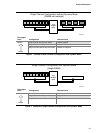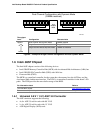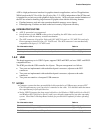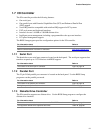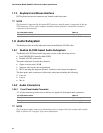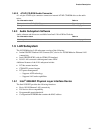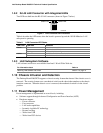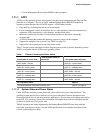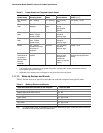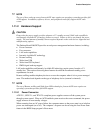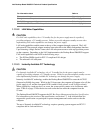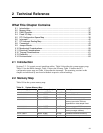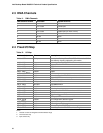
Product Description
31
Power Management Event signal (PME#) wake-up support
1.11.1 ACPI
ACPI gives the operating system direct control over the power management and Plug and Play
functions of a computer. The use of ACPI with the Desktop Board D865PCD requires an
operating system that provides full ACPI support. ACPI features include:
• Plug and Play (including bus and device enumeration)
• Power management control of individual devices, add-in boards (some add-in boards may
require an ACPI-aware driver), video displays, and hard disk drives
• Methods for achieving less than 15-watt system operation in the power-on/standby
sleeping state
• A Soft-off feature that enables the operating system to power-off the computer
• Support for multiple wake-up events (see Table 9 on page 32)
• Support for a front panel power and sleep mode switch
Table 7 lists the system states based on how long the power switch is pressed, depending on how
ACPI is configured with an ACPI-aware operating system.
Table 7. Effects of Pressing the Power Switch
If the system is in this state…
…and the power switch is
pressed for
…the system enters this state
Off
(ACPI G2/G5 – Soft off)
Less than four seconds Power-on
(ACPI G0 – working state)
On
(ACPI G0 – working state)
Less than four seconds Soft-off/Standby
(ACPI G1 – sleeping state)
On
(ACPI G0 – working state)
More than four seconds Fail safe power-off
(ACPI G2/G5 – Soft off)
Sleep
(ACPI G1 – sleeping state)
Less than four seconds Wake-up
(ACPI G0 – working state)
Sleep
(ACPI G1 – sleeping state)
More than four seconds Power-off
(ACPI G2/G5 – Soft off)
For information about Refer to
The Desktop Boards’ compliance level with ACPI Section 1.3, page 16
1.11.1.1 System States and Power States
Under ACPI, the operating system directs all system and device power state transitions. The
operating system puts devices in and out of low-power states based on user preferences and
knowledge of how devices are being used by applications. Devices that are not being used can be
turned off. The operating system uses information from applications and user settings to put the
system as a whole into a low-power state.
Table 8 lists the power states supported by the Desktop Board D865PCD and along with the
associated system power targets. See the ACPI specification for a complete description of the
various system and power states.



